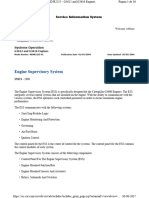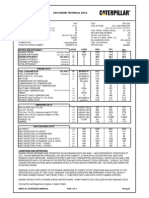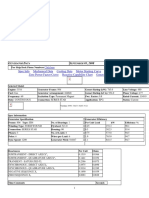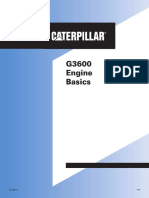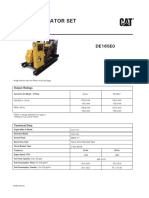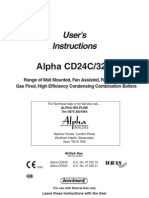100%(3)100% found this document useful (3 votes)
587 viewsG3520E Data Sheet
This document provides technical specifications for a G3520E gas engine, including:
- Engine operating speed of 1500 RPM fueled by natural gas
- Power output of 2000 kW at 100% load without fan
- Compression ratio of 11.6:1 and low pressure fuel system
- Cooling systems include jacket water, oil cooler, and two stage aftercooler
- Emission levels meet 250 mg/Nm3 NOx standard
- Engine derating factors and efficiency are provided for various operating conditions such as altitude, temperature, fuel quality.
Uploaded by
IwaiterCopyright
© © All Rights Reserved
Available Formats
Download as PDF, TXT or read online on Scribd
100%(3)100% found this document useful (3 votes)
587 viewsG3520E Data Sheet
This document provides technical specifications for a G3520E gas engine, including:
- Engine operating speed of 1500 RPM fueled by natural gas
- Power output of 2000 kW at 100% load without fan
- Compression ratio of 11.6:1 and low pressure fuel system
- Cooling systems include jacket water, oil cooler, and two stage aftercooler
- Emission levels meet 250 mg/Nm3 NOx standard
- Engine derating factors and efficiency are provided for various operating conditions such as altitude, temperature, fuel quality.
Uploaded by
IwaiterCopyright
© © All Rights Reserved
Available Formats
Download as PDF, TXT or read online on Scribd
You are on page 1/ 3
G3520E
GAS ENGINE TECHNICAL DATA
ENGINE SPEED: 1500 FUEL:
COMPRESSION RATIO: 11.6:1 FUEL SYSTEM: CAT LOW PRESSURE
AFTERCOOLER - STAGE 1 MAX. INLET (C): 87
AFTERCOOLER - STAGE 2 MAX. INLET (C): 43 FUEL PRESS. RANGE (KPAg): 3.5 - 34.5
J ACKET WATER - MAX. OUTLET (C): 94 MIN. METHANE NUMBER: 80
COOLING SYSTEM: J W+OC+1AC, 2AC RATED ALTITUDE (m): 400
IGNITION SYSTEM: ADEM3 AT AIR TO TURBO. TEMP. (C): 25
EXHAUST MANIFOLD: DRY NOx EMISSION LEVEL: 250 mg/Nm3
COMBUSTION: LOW EMISSION FUEL LHV (MJ /Nm3): 35.6
APPLICATION: GENSET
NOTES LOAD 100% 75%
50%
ENGINE POWER (WITHOUT FAN)
(1)
KW 2070 1553 1035
GENERATOR POWER (WITHOUT FAN) (2) EKW 2000 1500 1000
ENGINE EFFICIENCY (ISO 3046/1) (3) % 42.4 41.3 38.9
ENGINE EFFICIENCY (NOMINAL) (3) % 41.4 40.3 38.0
THERMAL EFFICIENCY (NOMINAL) (4) % 42.7 44.1 45.9
TOTAL EFFICIENCY (NOMINAL) (5) % 84.1 84.4 83.9
FUEL CONSUMPTION (ISO 3046/1) (6) MJ/bkW-hr 8.49 8.72 9.25
FUEL CONSUMPTION (NOMINAL) (6) MJ /bkW-hr 8.7 8.93 9.47
AIR FLOW (0 C, 101.3 kPa) (7) Nm3/bkW-hr 3.99 4.04 4.09
AIR FLOW (7) kg/bkW-hr 5.16 5.22 5.28
COMPRESSOR OUT PRESSURE kPa (abs) 418 325 223
COMPRESSOR OUT TEMPERATURE C 220 178 125
AFTERCOOLER AIR OUT TEMPERATURE C 47 47 47
INLET MAN. PRESSURE (8) KPAa 385 287 194
INLET MAN. TEMPERATURE
(MEASURED IN PLENUM)
(9) C 47 47 47
TIMING (10) BTDC 24 24 24
EXHAUST STACK TEMPERATURE (11) C 433 467 514
(12) Nm3/bkW-hr 4.24 4.3 4.36
EXHAUST MASS FLOW (12) kg/bkW-hr 5.35 5.42 5.49
NOx (as NO2) (corr. 5% O2) (13) mg/Nm3 (dry) 250 250 250
CO (corr. 5% O2) (14) mg/Nm3 (dry) 1093 1109 1111
THC (corr. 5% O2), molecular weight of 15.84) (14) mg/Nm3 (dry) 4260 4061 3098
NMHC (corr. 5% O2, molecular weight of 15.84) (14) mg/Nm3 (dry) 639 610 465
CO2 (corr. 5% O2) (14) mg/Nm3 (dry) 220578 209486 206749
EXHAUST O2 (15) % DRY 10.9 10.7 9.9
LAMBDA (15) 1.72 1.70 1.62
LHV INPUT (16) KW 5001 3851 2723
HEAT REJ ECTION TO J ACKET
(17)
KW 527 455 369
HEAT REJ ECTION TO ATMOSPHERE (18) KW 131 109 87
HEAT REJ ECTION TO LUBE OIL (19) KW 150 137 120
HEAT REJ ECTION TO EXHAUST (LHV to 25C) (20) KW 1556 1271 979
HEAT REJ ECTION TO EXHAUST (LHV to 120C) (20) KW 1076 908 703
HEAT REJ ECTION TO A/C - STAGE 1 (21) KW 382 197 56
HEAT REJ ECTION TO A/C - STAGE 2 (22) KW 186 129 76
CONDITIONS AND DEFINITIONS
ENGINE RATING IS WITHOUT ENGINE DRIVEN WATER PUMPS.
FOR NOTES INFORMATION CONSULT PAGE THREE.
DM5862-00 18-Sep-07 PAGE 1 OF 3
ENGINE RATING OBTAINED AND PRESENTED IN ACCORDANCE WITH ISO 3046/1. DATA REPRESENTS CONDITIONS OF
25C, 100 KPA BAROMETRIC PRESSURE, 30% RELATIVE HUMIDITY, 2.5 KPA AIR FILTER RESTRICTION, AND 5 KPA
EXHAUST STACK PRESSURE. ENGINE EFFICIENCY AND FUEL CONSUMPTION SPECIFICALLY NOTED AS ISO 3046/1 ARE
REPRESENTED WITH 1.25 KPA AIR FILTER RESTRICTION AND 0 KPA EXHAUST STACK PRESSURE. CONSULT ALTITUDE
CURVES FOR APPLICATIONS ABOVE MAXIMUM RATED ALTITUDE AND/OR TEMPERATURE. NO OVERLOAD PERMITTED
AT RATING SHOWN.
EMISSION LEVELS ARE BASED ON THE ENGINE OPERATING AT STEADY STATE CONDITIONS AND ADJ USTED TO THE
SPECIFIED NOx LEVEL AT 100% LOAD. EMISSION TOLERANCES SPECIFIED ARE DEPENDENT UPON FUEL QUALITY.
METHANE NUMBER CANNOT VARY MORE THAN 3. PUBLISHED PART LOAD DATA IS WITH LAMBDA CONTROL.
80MN NAT GAS
HEAT BALANCE DATA
EMISSIONS DATA
ENGINE DATA
RATING AND EFFICIENCY
EXHAUST GAS FLOW (0 C, 101.3 kPa)
WITH AIR FUEL RATIO CONTROL
G3520E
GAS ENGINE TECHNICAL DATA
30 35 40 45 50 55 60 65 70 75 80
- - - - - 16 18 20 22 23 24
0 0 0 0 0 0.85 0.93 1.00 1.00 1.00 1.00
50 0.934 0.909 0.884 0.860 0.836 0.812 0.788 0.753 0.650 0.547 no rating no rating no rating
45 0.966 0.941 0.916 0.891 0.867 0.842 0.818 0.783 0.703 0.598 no rating no rating no rating
AIR 40 1.000 0.974 0.949 0.923 0.898 0.874 0.849 0.813 0.754 0.651 0.547 no rating no rating
TO 35 1.000 1.000 0.982 0.957 0.931 0.906 0.881 0.844 0.784 0.705 0.600 no rating no rating
TURBO 30 1.000 1.000 1.000 0.991 0.965 0.940 0.914 0.877 0.816 0.756 0.654 no rating no rating
25 1.000 1.000 1.000 1.000 1.000 0.974 0.948 0.910 0.848 0.787 0.710 0.500 no rating
(C) 20 1.000 1.000 1.000 1.000 1.000 1.000 0.984 0.945 0.882 0.820 0.760 0.554 no rating
15 1.000 1.000 1.000 1.000 1.000 1.000 1.000 0.981 0.916 0.854 0.792 0.611 no rating
10 1.000 1.000 1.000 1.000 1.000 1.000 1.000 1.000 0.952 0.888 0.826 0.669 no rating
0 100 200 300 400 500 600 750 1000 1250 1500 2000 2500
ALTITUDE (METERS ABOVE SEA LEVEL)
50 1.22 1.23 1.25 1.26 1.27 1.27 1.27 1.27 1.27 1.27 no rating no rating no rating
45 1.17 1.19 1.20 1.21 1.22 1.22 1.22 1.22 1.22 1.22 no rating no rating no rating
AIR 40 1.13 1.14 1.15 1.16 1.17 1.17 1.17 1.17 1.17 1.17 1.17 no rating no rating
TO 35 1.08 1.09 1.10 1.11 1.13 1.13 1.13 1.13 1.13 1.13 1.13 no rating no rating
TURBO 30 1.03 1.04 1.05 1.07 1.08 1.08 1.08 1.08 1.08 1.08 1.08 no rating no rating
25 1.00 1.00 1.01 1.02 1.03 1.03 1.03 1.03 1.03 1.03 1.03 1.03 no rating
(C) 20 1.00 1.00 1.00 1.00 1.00 1.00 1.00 1.00 1.00 1.00 1.00 1.00 no rating
15 1.00 1.00 1.00 1.00 1.00 1.00 1.00 1.00 1.00 1.00 1.00 1.00 no rating
10 1.00 1.00 1.00 1.00 1.00 1.00 1.00 1.00 1.00 1.00 1.00 1.00 no rating
0 100 200 300 400 500 600 750 1000 1250 1500 2000 2500
ALTITUDE (METERS ABOVE SEA LEVEL)
100% Load Data dB(A) (dB)
1 111.8 62.4 88.1 89.8 95.3 99.3 98.6 97.3 107.6
7 94.9 45.5 71.2 72.9 78.4 82.4 81.7 80.4 90.7
15 88.3 38.9 64.6 66.3 71.8 75.8 75.1 73.8 84.1
1.5 114.6 90.4 100.0 98.9 103.0 99.1 102.4 99.8 101.5
7 101.2 77.0 86.6 85.5 89.6 85.7 89.0 86.4 88.1
15 94.6 70.4 80.0 78.9 83.0 79.1 82.4 79.8 81.5
Overal SPL 63 Hz 125 Hz 250 Hz 500 Hz 1 kHz 2 kHz 4 kHz 8 khz
Octave Band Center Frequency (OBCF)
FUEL USAGE GUIDE:
This table shows the derate factor required for a given fuel. Note that deration occurs as the methane number decreases. Methane number is a scale to measure
detonation characteristics of various fuels. The methane number of a fuel is determined by using the Caterpillar Methane Number Calculation program.
ALTITUDE DERATION FACTORS:
This table shows the deration required for various air inlet temperatures and altitudes. Use this information along with the fuel usage guide chart to help
determine actual engine power for your site.
INLET AND EXHAUST RESTRICTION CORRECTIONS FOR ALTITUDE CAPABILITY:
To determine the appropriate altitude derate factor to be applied to this engine for inlet or exhaust restrictions differering fromthe
standard conditions listed on page 1, a correction to the site altitude can be made to adjust for this difference. Add 43 meters to the site
altitude for each additional kPa of exhaust stack pressure greater than spec sheet conditions. Add 86 meters to the site altitude for each
additional kPa of inlet restriction greater than spec sheet conditions. If site inlet restriction or exhaust stack pressure
are less than spec sheet conditions, the same trends apply to lower the site altitude.
ACTUAL ENGINE RATING:
It is important to note that the Altitude/Temperature deration and the Fuel Usage Guide deration are not cumulative. They are not to be added together. The
same is true for the Low Energy Fuel deration (reference the Caterpillar Methane Number Program) and the Fuel Usage Guide deration. However, the
Altitude/Temperature deration and Low Energy Fuel deration are cumulative; and they must be added together in the method shown below. To determine
the actual power available, take the lowest rating between 1) and 2).
1) (Altitude/Temperature Deration) +(Low Energy Fuel Deration)
2) Fuel Usage Guide Deration
Note: For NA's always add the Low Energy Fuel deration to the Altitude/Temperature deration. For TA engines only add the Low Energy Fuel
deration to the Altitude/Temperature deration whenever the Altitude/Temperature deration is less than 1.0 (100%). This will give the actual rating
for the engine at the conditions specified.
AFTERCOOLER HEAT REJECTION FACTORS:
Aftercooler heat rejection is given for standard conditions of 25C and 152 maltitude. To maintain a constant air inlet manifold temperature, as the air to turbo
temperature goes up, so must the heat rejection. As altitude increases, the turbocharger must work harder to overcome the lower atmospheric pressure.
This increases the amount of heat that must be removed fromthe inlet air by the aftercooler. Use the aftercooler heat rejection factor to adjust for ambient and
altitude conditions. Multiply this factor by the standard aftercooler heat rejection. Failure to properly account for these factors could result in detonation and
cause the engine to shutdown or fail. For 2 Stage Aftercoolers with separate circuits, the 1st stage will collect 88% of the additional heat.
SOUND DATA:
Data determined by methods similar to ISO Standard DIS-8528-10. Accuracy Grade 3. SPL =Sound Pressure Level.
DM5862-00
24
FUEL USAGE GUIDE
CAT METHANE NUMBER
IGNITION TIMING
85 to 100
PAGE 2 OF 3 18-Sep-07
FREE FIELD MECHANICAL & EXHAUST NOISE
Free Field
Exhaust
Free Field
Mechanical
DISTANCE FROM
THE ENGINE
(METERS)
DISTANCE FROM
THE ENGINE
(METERS)
DERATION FACTOR 1.00
ALTITUDE DERATION FACTORS
AFTERCOOLER HEAT REJECTION FACTORS
G3520E
GAS ENGINE TECHNICAL DATA
NOTES
1 ENGINE RATING IS WITHOUT ENGINE DRIVEN WATER PUMPS. TOLERANCE IS 3% OF FULL LOAD.
2 GENERATOR POWER DETERMINED WITH AN ASSUMED GENERATOR EFFICIENCY OF 96.6% AND POWER
FACTOR OF 0.8 [GENERATOR POWER =ENGINE POWER x GENERATOR EFFICIENCY].
3 ISO 3046/1 ENGINE EFFICIENCY TOLERANCE IS (+)0, (-)5% OF FULL LOAD % EFFICIENCY VALUE. NOMINAL
ENGINE EFFICIENCY TOLERANCE IS 2.5% OF FULL LOAD % EFFICIENCY VALUE.
4 THERMAL EFFICIENCY: J ACKET HEAT +LUBE OIL HEAT +STAGE 1 A/C HEAT +EXH. HEAT TO 120C.
5 TOTAL EFFICIENCY =ENGINE EFF. +THERMAL EFF. TOLERANCE IS 10% OF FULL LOAD DATA.
6 ISO 3046/1 FUEL CONSUMPTION TOLERANCE IS (+)5, (-)0% OF FULL LOAD DATA. NOMINAL FUEL
CONSUMPTION TOLERANCE IS 2.5 % OF FULL LOAD DATA.
7 UNDRIED AIR. FLOW TOLERANCE IS 5 %
8 INLET MANIFOLD PRESSURE TOLERANCE IS 5 %
9 INLET MANIFOLD TEMPERATURE TOLERANCE IS 5C.
10 TIMING INDICATED IS FOR USE WITH THE MINIMUM FUEL METHANE NUMBER SPECIFIED. CONSULT THE
APPROPRIATE FUEL USAGE GUIDE FOR TIMING AT OTHER METHANE NUMBERS.
11 EXHAUST STACK TEMPERATURE TOLERANCE IS (+)35C, (-)30C.
12 WET EXHAUST. FLOW TOLERANCE IS 6 %
13 NOX TOLERANCES ARE 18 % OF SPECIFIED VALUE.
14 CO, CO2, THC, and NMHC VALUES ARE "NOT TO EXCEED".
15 O2% TOLERANCE IS 0.5; LAMBDA TOLERANCE IS 0.05. LAMBDA AND O2 LEVEL ARE THE RESULT OF
ADJ USTING THE ENGINE TO OPERATE AT THE SPECIFIED NOX LEVEL.
16 LHV RATE TOLERANCE IS 2.5%.
17 TOTAL J W HEAT (based on treated water) =J ACKET HEAT +LUBE OIL HEAT +STAGE 1 A/C HEAT +0.88 x
(STAGE 1 +STAGE 2) x (ACHRF-1). TOLERANCE IS 10 % OF FULL LOAD DATA.
18 RADIATION HEAT RATE BASED ON TREATED WATER. TOLERANCE IS 50% OF FULL LOAD DATA.
19 LUBE OIL HEAT RATE BASED ON TREATED WATER. TOLERANCE IS 20% OF FULL LOAD DATA.
20 EXHAUST HEAT RATE BASED ON TREATED WATER. TOLERANCE IS 10% OF FULL LOAD DATA.
21 STAGE 1 A/C HEAT (based on treated water) =STAGE 1 A/C HEAT +0.88 x (STAGE 1 +STAGE 2) x (ACHRF-1).
TOLERANCE IS 5 % OF FULL LOAD DATA.
22 STAGE 2 A/C HEAT (based on treated water) =STAGE 2 A/C HEAT +(STAGE 1 +STAGE 2) x 0.13 x (ACHRF - 1).
TOLERANCE IS 5 % OF FULL LOAD DATA.
DM5862-00 PAGE 3 OF 3 18-Sep-07
You might also like
- Engine Supervisory System: Systems OperationNo ratings yetEngine Supervisory System: Systems Operation36 pages
- Use of Gas Gensets in Standby Applications100% (1)Use of Gas Gensets in Standby Applications51 pages
- PROCEDIMIENTO - Cylinder Head - DisassembleNo ratings yetPROCEDIMIENTO - Cylinder Head - Disassemble9 pages
- REHS1438-09 Installation and Initial Start-Up Procedure For G3500C and G3500E Generator Set Engines PDF67% (3)REHS1438-09 Installation and Initial Start-Up Procedure For G3500C and G3500E Generator Set Engines PDF52 pages
- CAT Engine Valve Lash and Valve Bridge Adjustment ToolsNo ratings yetCAT Engine Valve Lash and Valve Bridge Adjustment Tools9 pages
- 3508B Engine Speed Timing Sensor - Calibrate2No ratings yet3508B Engine Speed Timing Sensor - Calibrate25 pages
- C32 Syc03519 - PSRPT - 2019-11-06 - 17.53.14 PDF100% (1)C32 Syc03519 - PSRPT - 2019-11-06 - 17.53.14 PDF4 pages
- D 0906-110-E000D - Released: Drawing Sheet & Revision Status Sheet No. Rev. Sym. Sheet No. Rev. Sym. Sheet No. Rev. SymNo ratings yetD 0906-110-E000D - Released: Drawing Sheet & Revision Status Sheet No. Rev. Sym. Sheet No. Rev. Sym. Sheet No. Rev. Sym1 page
- Diesel Engines 16V 4000 M93/M93L: For Fast Vessels With Low Load Factors (1DS)No ratings yetDiesel Engines 16V 4000 M93/M93L: For Fast Vessels With Low Load Factors (1DS)2 pages
- 3512B Generator Set Oil Field Land Rig PTF00001-UP (SEBP3451 - 80) - Systems & Components100% (1)3512B Generator Set Oil Field Land Rig PTF00001-UP (SEBP3451 - 80) - Systems & Components2 pages
- Fumes Disposal Filter For Certain G3500 Series EnginesNo ratings yetFumes Disposal Filter For Certain G3500 Series Engines23 pages
- (REHS0371) Installation and Initial Start Up Procedures For G3300 and G3400 Engines100% (1)(REHS0371) Installation and Initial Start Up Procedures For G3300 and G3400 Engines16 pages
- Series: 973 - 1327 KWM (Gross) at 1500 RPMNo ratings yetSeries: 973 - 1327 KWM (Gross) at 1500 RPM18 pages
- Cartepillar C32 Diesel Oilfield Generator SetNo ratings yetCartepillar C32 Diesel Oilfield Generator Set4 pages
- Motortech Salesflyer Caterpillar Ignition Coils 01.15.017 en 2016 08No ratings yetMotortech Salesflyer Caterpillar Ignition Coils 01.15.017 en 2016 0812 pages
- Gas Engine Technical Data: Load 100% 75% 50% Rating and EfficiencyNo ratings yetGas Engine Technical Data: Load 100% 75% 50% Rating and Efficiency3 pages
- Gas Engine Technical Data: Load 100% 75% 50% Rating and EfficiencyNo ratings yetGas Engine Technical Data: Load 100% 75% 50% Rating and Efficiency3 pages
- Casting Material: Carbon Steel BS3100 Gr. A4No ratings yetCasting Material: Carbon Steel BS3100 Gr. A45 pages
- Beer Johnston Mechanics of Materials 6th TXTBKNo ratings yetBeer Johnston Mechanics of Materials 6th TXTBK2 pages
- Shinddaiwa EB8510 Blower Llustrated Parts ListNo ratings yetShinddaiwa EB8510 Blower Llustrated Parts List18 pages
- The Following Permissive Must Be Met Before Boiler Purge Can Take PlaceNo ratings yetThe Following Permissive Must Be Met Before Boiler Purge Can Take Place11 pages
- Structural Analysis Computation Manual ExcelNo ratings yetStructural Analysis Computation Manual Excel29 pages
- Soil Investigation Works Method StatementNo ratings yetSoil Investigation Works Method Statement5 pages
- ODUS - Product Data Sheet - Mercedes - Benz - Wallbox - Home - With - Fixed - Charging - Cable - Up - To - 22 - KWNo ratings yetODUS - Product Data Sheet - Mercedes - Benz - Wallbox - Home - With - Fixed - Charging - Cable - Up - To - 22 - KW2 pages
- Introduction To Non-Destructive Testing (NDT)No ratings yetIntroduction To Non-Destructive Testing (NDT)38 pages
- Grade 9 Forces and Laws Motion Worksheet 2 Answer KeyNo ratings yetGrade 9 Forces and Laws Motion Worksheet 2 Answer Key8 pages
- AMERICAN SpiralWeld Pipe - Linings and CoatingsNo ratings yetAMERICAN SpiralWeld Pipe - Linings and Coatings6 pages
